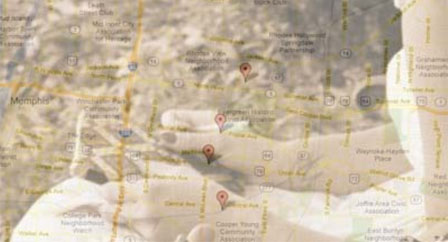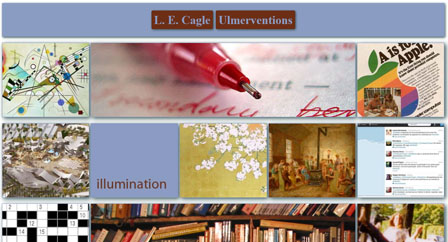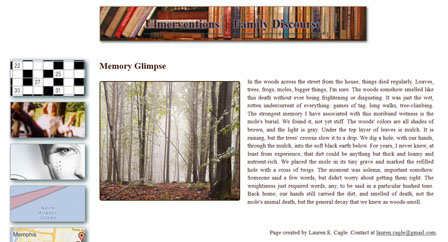Our [Electrate] Stories
Explicating Ulmer's Mystory Genre
Marc C. Santos, Ella R. Bieze, Lauren E. Cagle, Jason C., Zachary P. Dixon, Kristen N. Gay, Sarah Beth Hopton, Megan M. McIntyre
Reflection: Lauren E. Cagle
1. What work does a mystory do?
In the process of unearthing memories to populate our mystories, we also discover themes that run beneath and through our encounters with those institutions and the people, images, and narratives that populate them. For example, in the process of creating my mystory, I discovered a pervasive concern with the state of being in-between and away from. This discovery allowed me to understand my upbringing in two cultures as a reflection of—or, to use Gregory L. Ulmer’s term, a relay for—the experience of code-switching as I changed career paths with each degree I’ve pursued.
I think this process of discovery serves two purposes. First, it enables us to know ourselves more fully before attempting to know others. The mystory illustrates for us the complex network of relations and influences, many half-forgotten or undervalued, that shaped us, usually affectively rather than logically. In turn, we can better appreciate the complexity of enacting change by attempting to influence others, and the often fruitless application of Cartesian logic in that process. Second, and relatedly, the mystory explores the possibilities for electracy by pushing us to create new ways of ordering and presenting information that rely not on step-by-step logic, but on images which can produce a punctum, “that which stings or pricks one emotionally” (Ulmer, 2003, p. 44).
These two goals are inextricable from each other. The tracing of identity’s many sources, influences, and effects through the mystory puts the lie to “the social scientific view of normal effective behavior” as “involv[ing] a decision-making process directed by the coordination of plans and goals” (Ulmer, 2003, p. 76). No behavior, the mystory suggests, is so straightforward or can be understood so simply; rather we must embrace all that does not seem decided, coordinated, or planned in order to explain how we are and what we do. Once the mystory has shifted our attention from the logical progression of our behavior to the networked influences on our behaviors, we approach “an electrate state of mind [which] includes a tolerance for nonutilitarian, inefficient, irrelevant events and experiences” (Ulmer, 2003, p. 76).
Developing electracy and understanding one’s identity in an affective, nonlinear way, then, are the work the mystory does. Each type of work supports and furthers the other, paving the way for the more publicly-oriented work Ulmer (2005) prompts in Electronic Monuments, which he described as “the next stage of EmerAgency” (Ulmer, 2003, p. 324).
2. Does the mystory realize Ulmer’s aspirations?
While I understand Ulmer’s call for electracy as a development beyond literacy (especially through the analogy of literacy’s relation to orality), I do not see the mystory as an answer to that call. We—the graduate students making online mystories—filled our pages with images; I even chose to make all of my navigation links images, so that the landing page would, at first, be nothing but a wash of images. However, we all also filled our pages with text. That text explained those images, put them in context, reframed them, and instructed the reader on their interpretation. Even the image links on my homepage transformed into a blank background with text when a user hovered over them. Given this preponderance of text, typically presented in a familiarly linear fashion, how do our mystories move away from literacy, literally understood? While I’m not prepared to argue that they don’t, it remains unclear how and how much they do.
However, through the experiences of both creating a mystory and reading others’ mystories, we can explore not only what literacy does and doesn’t offer us in terms of creation but also in terms of reception. Ulmer says that the best response to someone reading your mystory is another mystory. On the subject of the immediate response in the moment of reading, however, Ulmer stays silent; he provides no guidance as to how to respond to the personal and affective memories shared throughout the mystory. This lack leaves us responding using approaches to written work that we have learned through literacy. When we grad students discussed our mystories, we went around and around, critiquing the project, finding aspects of it to praise, connecting Ulmer to other theorists, and generally using big words and being smart. But what we did very little of was actually talk about the content of our mystories, even though many of us had read at least some of each other's. These conversations point to yet another way of being that literacy has not prepared us for: being a listener, not a creator; an emotional respondent, not a critiquer.
3. Can/should you learn Ulmer while learning HTML and CSS?
In traditional martial arts training, the master consistently pushes the apprentice beyond exhaustion to the very edge of collapse. This is not sadism. It is a deliberate means of teaching reliance on instinct and one’s body. Always training while fresh and alert leads to overthinking every move. Utter exhaustion turns the mind off and allows instinct to take over from logic and reason.
Similarly, creating a mystory while learning HTML and CSS created a state of overwork and exhaustion. The coding, I quickly learned, could fill hours that passed like minutes, as I kept learning and trying new things and botching them and fixing them and then thinking of something else to try. In between, I created the content for the mystory’s discourses by writing, searching for images, and photoshopping. These dual tasks—coding and content—pushed us to the edge. The need to always be paying attention to two challenging and very different tasks forced me to bypass the professional student’s impulse to overthink every detail in an effort to do the assignment exactly right. Oddly, learning HTML and CSS while creating a mystory thus prompts the shift away from logical processes to the immediate affective responses for which electracy calls.
Moreover, the simultaneity of learning coding and creating the mystory leads to a certain serendipity of invention. As an undefined genre, the mystory comes without preconceptions about how it should be visually presented and how its pieces should be hyperlinked. The development of the content is therefore always accompanied by the question of how that content might be presented. Without the mystory guiding me, I may not have discovered how to make images into links, or how to make those images change when they’re hovered on, or how to make a javascript flipbook whose pages can be turned with a swipe of the mouse. In turn, burgeoning knowledge of HTML and CSS occasionally drove the invention of content. For example, my Entertainment Discourse focuses on an animated movie I only barely remember watching as a child. Initially, my impulse was to focus on a book since I’ve always been a reader. The desire to embed a video, however, drove me to remember harder until I finally recalled just a smear of the movie I then fruitfully rewatched and wrote about.
So, my advice is to create a mystory and learn HTML and CSS simultaneously. It will be frustrating and exhausting, but frustration and exhaustion help bypass the well-worn paths to assignment completion that we’ve all taken as graduate students.
4. Should a mystory be public or private?
Whether or not a mystory should be public or private is a troubling question. It leads us to reassess our first question: what is the purpose of the mystory? In other words, the act of sharing or not sharing a mystory shapes the mystory’s compositional process. If it is completely private, I can write about my most deeply held anxieties and moments of high hubris and embarrassing memories. I can be Not Suitable for Work (NSFW)—my work that is, where I am expected to be professional, academic, intelligent, and pulled-together. On the other hand, if the mystory is public, the spectre of censorship immediately haunts the process.
The presence of such a spectre need not derail the mystory’s purpose, however. I chose to make my mystory live on the web. I did not advertise it or link to it from my professional site. It is discoverable via Google, though, and a number of my classmates know the direct link. This pseudopublic approach, with the constant potential for a live, human audience forced a personal confrontation with my own ghosts. I constantly questioned what to elide and cover up and disinclude in my mystory. More importantly, I wondered why I elided and covered up and disincluded certain things. This line of questioning, I believe, suits the mystory’s purpose(s). It prompts us to consider why we—especially in academia—are so deeply uncomfortable with the personal, and thereby gives us experiential access to the potential problems of a logocentric literacy.
5. What else do you want to say?
Although Ulmer allows for mystories to be created in analog as well as digital formats, I think it’s important to recognize what the digital promises that the analog does not. Digital work enjoys a kind of always-able-to-be-revised nature that mirrors the never-ending tracing of the mystory. Like Paul Valery’s poems, mystories are never finished—just abandoned. Even after being published, they always hold the potential for further revision. This potential reflects a deep difference between literate and electrate texts. In theory, all created work could be revised; in practice, however, the potential for revision in analog and digital formats differs vastly. When something is—bottom-line—nothing but 1’s and 0’s on a server, changing it may require the cutting of red tape, but it definitely requires the marshalling of few physical resources. In comparison, once something’s in print, that’s all she wrote. It’s done. The cost and effort of recalling and revising a print text are prohibitive. But knowledge in pixel form is immanently more flexible, which makes pixels the ideal container for the flexible and amorphous genre of the mystory.


